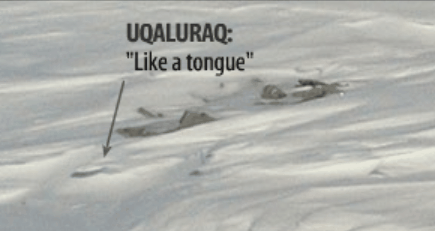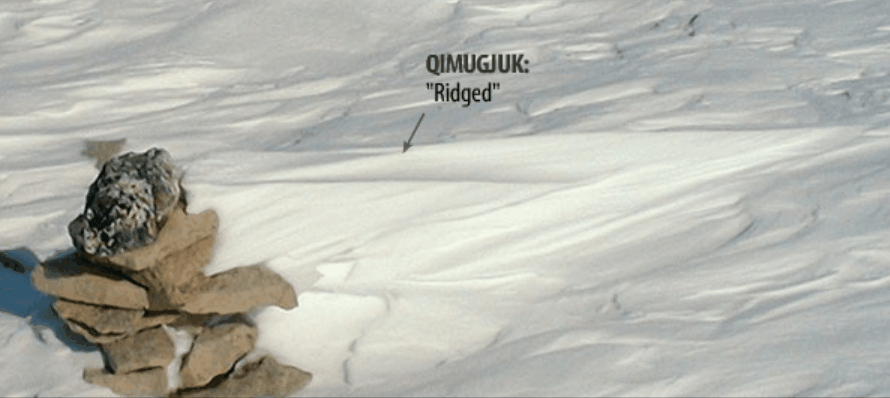
ᐅᖃᓗᕋᐃᑦ
[SNOW & SNOWDRIFTS]
SNOW & SNOWDRIFTS
The land and sea ice around Igloolik is snow covered for almost nine months of the year: from October to early June. Inuit recognize and name different types of snow conditions and snowdrifts. For example, we all know about mauja, deep soft snow, but there are other names, such as qaniut, for fresh snow and pukakjiq, the preferred snow for making igloos. A good knowledge and understanding of snow is also needed for building proper igloos. Over the winter the snow is constantly being shaped by the winds into different types of drifts that are used by hunters for navigation.
TALKING ABOUT SNOW and SNOWDRIFTS
Below, you will hear Emile Imaruittuq and Michel Kupaaq use the names for many snow conditions and varieties of snowdrifts.


EMILE IMARUITTUQ
uses the names for many snow conditions and snowdrifts.
[Swipe right for continued
translation below >>> ]

MICHEL KUPAAQ
uses the names for many snow conditions and snowdrifts.
[Swipe right for continued
translation below >>> ]
RECOGNIZING SNOWDRIFTS
The most important drifts to recognize and the ones used often by hunters are uqaurait and qimugjuit. Both of these drifts are formed by the Uangnaq wind.



The different types of snowdrifts are outlined above.

HOW SNOWDRIFTS are FORMED
In the early fall, heavy snowfall makes large, soft, rounded drifts called uluangnait, so named because they look like cheeks. Later, the uluangnait are shaped by winds, especially the Uangnaq wind into drifts called uqalurait. These drifts are tongue shaped. Uangnaq also creates another kind of drift known as qimugjuk, meaning "ridged", because it forms on the lee side of an obstacle, such as a rock or raised piece of sea ice exposed to the wind.

Watch as snowdrifts form in the above animation.

ABRAHAM ULAAJURULUKK
on life at the Agiuppiniit camp.
[Swipe right for continued
translation below >>> ]
UQALURAIT: THE SNOW COMPASS
We have just heard Arbaham Ulaajuruluk tell us how uqalurait are formed by the Uangnaq wind. Uqalurait are the most noticeable drifts and last throughout the winter. They are like a compass because they always point in the direction of Uangnaq. Hunters use uqalurait as a reliable method of wayfinding.
Maurice Arnatsiaq on the formation of uqalurait and qimugjuit snowdrifts.
AIPILIK INNUKSUK
on using uqalurait for wayfinding.
"WHEN ONE IS ON THE LAND or on the landfast ice, the best indicators are the snowdrifts called uqalurait. These are caused by the wind and are the best to determine in which direction one is travelling. One has to keep observing these snow forms. After a strong snowstorm there are going to be drift formations on the ground caused by the storm so it is good to keep in mind the direction the wind was blowing from during the storm. There are times when one loses his bearing on land or on the ice, so it is best to position yourself on these snow forms. For instance, if you have a destination you should watch how you are cutting across the uqalurait drifts. There are times when the uqalurait drifts may be buried with fresh snow. In this case all you have to do is kick around the fresh snow to get at the uqaluraq form below. Those are the things that one should keep in mind. We just had a strong storm so all the drifts it created will now be stable for the rest of the winter even if they get covered with new snow. When a wind blows hard from any direction it will create a distinguished snow form that cannot be removed by any other snow or wind. So, it is important to keep these snowdrift forms in mind" (Aipilik Innuksuk IE-165, 1990).

ULAAJURULUK,
on using uqalurait for wayfinding.
Q. Do these uqalurait have any use?
A. Definitely. Now you have started to drink tea and coffee, all you would have to do is cut off the uqaluraq and melt it to make tea. If you were travelling while it was dark or in a white-out with a specific destination in mind, or even in a blizzard or in fog, one thing to keep in mind is that the qimugjuit always face Uangnaq. So, with these as a navigational aid you can get to your destination. This is the only use these formations have, they have no other use. These snow formations are not what we want because they are nothing but hindrance in our journey. Nonetheless, they have a use that you really cannot do without in obscure conditions. Qimugjuit all face Uangnaq, therefore, uqalurait also face Uangnaq. When you are caught in the dark, or in a blizzard, and the visibility is low you will need the only aid that is available - and these are the snowdrifts. They have no other use (Abraham Ulaajuruluk IE-256, 1993).